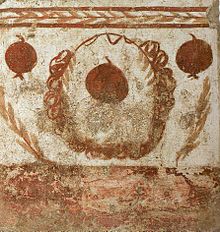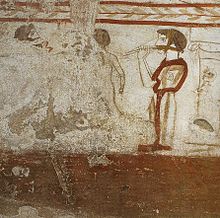Grave of pomegranates
The grave of the pomegranates is probably a man's grave from around 360 BC. Its remains were found in 1937 in the Andriulo necropolis near Paestum and are kept in the National Archaeological Museum in Paestum .
The tomb was discovered and excavated earlier than many other Paestan tombs; the findings at that time were not documented, so that the original arrangement of the wall panels is not known. However, the comparison with similar graves, in particular with the grave of the returning knight and the grave of the deer hunt , suggests the original position of the plates and the identity of the buried. It was probably a young knight.
Paintings
The four walls of the burial chamber are rectangular, so that the chamber does not have to have a gable roof, but a simple cover plate. The panels on the narrow sides measure 91 × 91 cm, those on the long sides 93 × 221 cm. About the lower quarter of all four plates is painted dark red-brown; The figurative representations move on this background. A branch motif between two red lines forms the upper end.
The plate of the presumably eastern narrow side of the burial chamber shows the motif of the returning knight. He rides an unsaddled, brown, left-striding horse with a lantern , the red reins of which he leads with his right hand. He is barefoot, but wears a helmet and armor as well as a belt and armor on a kind of flagpole that lies over his shoulder, which are probably to be regarded as items of booty. He leads two handcuffed prisoners behind him on two ropes, a long-bearded man with tangled hair and a second, whose beard is apparently trimmed. The knight is welcomed by a female figure in a long, red-bordered robe, who holds out a drinking vessel with her right hand. The robes of all the people depicted are made with narrow, dark outlines and broad, dark red brushstrokes. The heads and limbs of the people are also only indicated by outlines, but not, as in younger graves, by a darker skin color against the background.
The grave was named after the painting on the other narrow side, which shows three oversized pomegranates with branches and a wreath.
On the panels on the long sides, scenes from the funeral games can be seen. One plate shows a scene from a chariot race; two couples follow each other in a scene of plants to the right and left, a column in the middle and hanging garlands. The second plate is also divided by a column. In the left third of the picture, to the left of the column, you can still see two boxing men and a musician who is facing them and plays the flute. To the right of the column, two naked men armed with helmets, shields and greaves are fighting each other with weapons. A third, in a long robe, standing on the right edge of the scene, holds up a wreath in his right hand. Behind him the rest of the plate is filled by a tree.
The paintings of the grave of the pomegranates have partly double contours, which suggests corrections made after the first sketch of the scenes.
exhibition
The grave slabs of the grave of the pomegranates were shown in an exhibition in the Bucerius Kunst Forum in 2007 and in the Martin-Gropius-Bau in Berlin in 2008 . On the occasion of this exhibition they were put together to form a grave and thus presented in the assumed original arrangement. In the museum in Paestum, the plates can only be shown individually because of their great weight.
literature
- Angela Pontrandolfo , Agnès Rouveret : Le tombe dipinte di Paestum. Panini, Modena 1992, ISBN 88-7686-202-1
- Bernard Andreae and others: painting for eternity. The tombs of Paestum. Exhibition at Bucerius Kunst Forum Hamburg, October 13, 2007 to January 20, 2008. Hirmer, Munich 2007, ISBN 978-3-7774-3745-3 , pp. 68–75
Individual evidence
- ↑ Paestum, Museo Archeologio Nazionale Inv.-No. 5005-5008


